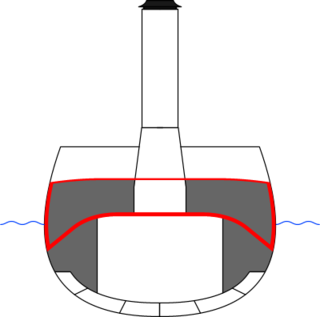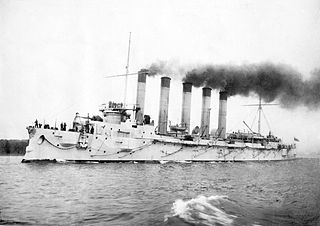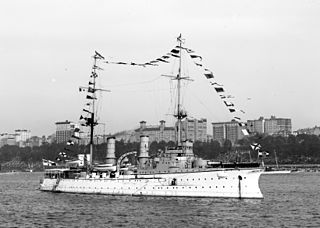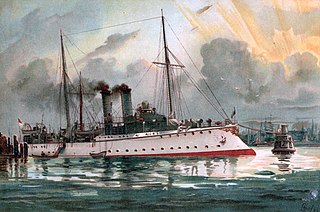
In naval terminology, a destroyer is a fast, maneuverable, long-endurance warship intended to escort larger vessels in a fleet, convoy or battle group and defend them against powerful short range attackers. They were originally developed in 1885 by Fernando Villaamil for the Spanish Navy as a defense against torpedo boats, and by the time of the Russo-Japanese War in 1904, these "torpedo boat destroyers" (TBDs) were "large, swift, and powerfully armed torpedo boats designed to destroy other torpedo boats". Although the term "destroyer" had been used interchangeably with "TBD" and "torpedo boat destroyer" by navies since 1892, the term "torpedo boat destroyer" had been generally shortened to simply "destroyer" by nearly all navies by the First World War.

The armored cruiser was a type of warship of the late 19th and early 20th centuries. It was designed like other types of cruisers to operate as a long-range, independent warship, capable of defeating any ship apart from a battleship and fast enough to outrun any battleship it encountered.

SMS Baden was a Bayern-class dreadnought battleship of the German Imperial Navy built during World War I. Launched in October 1915 and completed in March 1917, she was the last battleship completed for use in the war; two of her sisters—Sachsen and Württemberg—were incomplete when the war ended. The ship mounted eight 38-centimeter (15 in) guns in four twin turrets, displaced 32,200 metric tons at full combat load, and had a top speed of 21 knots. Along with her sister Bayern, Baden was the largest and most powerfully armed battleship built by the Imperial Navy.

Askold was a protected cruiser built for the Imperial Russian Navy. She was named after the legendary Varangian Askold. Her thin, narrow hull and maximum speed of 23.8 knots (44.1 km/h) were considered impressive for the time.

Novík was a protected cruiser in the Imperial Russian Navy, built by Schichau shipyards in Elbing near Danzig, Germany.

HMS Algerine was a Phoenix-class steel screw sloop of the Royal Navy. She was launched at Devonport in 1895, saw action in China during the Boxer Rebellion, and later served on the Pacific Station. She was stripped of her crew at Esquimalt in 1914, and transferred to the Royal Canadian Navy in 1917, being commissioned as HMCS Algerine. She was sold as a salvage vessel in 1919 and wrecked in 1923.
Seven ships of the Royal Navy have borne the name HMS Alexander:

The Victoria Louise class of protected cruisers was the last class of ships of that type built for the German Imperial Navy. The class design introduced the combined clipper and ram bow and the blocky sides that typified later German armored cruisers. The class comprised five vessels, Victoria Louise, the lead ship, Hertha, Freya, Vineta, and Hansa. The ships were laid down in 1895–1896, and were launched in 1897–1898 and commissioned into the fleet over the following year.

HMS Barfleur was the second and last of the Centurion-class pre-dreadnought battleships built for the Royal Navy in the 1890s. Intended for service abroad, they exchanged heavy armour and a powerful armament for high speed and long range to counter the foreign armoured cruisers then being built as commerce raiders and were rated as second-class battleships.

SMS Kaiserin und Königin Maria Theresia was an armored cruiser used by the imperial Austro-Hungarian Navy from 1895 to 1917; she was the first ship of that type built by the Austro-Hungarian Navy. The ship was a unique design, built by the Stabilimento Tecnico Triestino shipyard in Trieste; she was laid down in July 1891, launched in April 1893, and completed in November 1894. Armed with a main battery of two 24-centimeter (9.4 in) guns and eight 15 cm (5.9 in) guns, the ship provided the basis for two subsequent armored cruiser designs for the Austro-Hungarian Navy.

The Cruizer class was a class of six 17-gun wooden screw sloops built for the Royal Navy between 1852 and 1856.
Eight ships of the Royal Navy have been named HMS Algerine:

Imperator Aleksandr II was a battleship built for the Imperial Russian Navy in the 1880s. She was an artillery training ship assigned to the Baltic Fleet by the time of the Russo-Japanese War of 1905 and was not sent to the Pacific as was most of the rest of the Baltic Fleet. She was inactive at Kronstadt during World War I, but her crew was active in the revolutionary movement. She was turned over to the Kronstadt port authority on 21 April 1921 before she was sold for scrap on 22 August 1922. She was towed to Germany during the autumn of 1922, but was not stricken from the Navy List until 21 November 1925.

The Kolberg class was a group of four light cruisers built for the German Imperial Navy and used during the First World War. The class comprised four vessels: SMS Kolberg, the lead ship, Mainz, Cöln, and Augsburg. The ships were built between 1908 and 1910, and two, Kolberg and Augsburg, were modernized in 1916–1917. The ships were armed with a main battery of twelve 10.5 cm SK L/45 guns and had a design speed of 25.5 knots. The first three ships were assigned to the reconnaissance forces of the High Seas Fleet; Augsburg was instead used as a torpedo and gunnery training ship.

SMS Gefion was an unprotected cruiser of the German Kaiserliche Marine, the last ship of the type built in Germany. She was laid down in March 1892, launched in March 1893, and completed in June 1895 after lengthy trials and repairs. The cruiser was named after the earlier sail frigate Gefion, which had been named for the goddess Gefjon of Norse mythology. Intended for service in the German colonial empire and as a fleet scout, Gefion was armed with a main battery of ten 10.5-centimeter (4.1 in) guns, had a top speed in excess of 19.5 knots, and could steam for 3,500 nautical miles, the longest range of any German warship at the time. Nevertheless, the conflicting requirements necessary for a fleet scout and an overseas cruiser produced an unsuccessful design, and Gefion was rapidly replaced in both roles by the newer Gazelle class of light cruisers.

HMS Fame was a two funnel, 30 knot destroyer of the Royal Navy, ordered under the 1894 – 1895 Naval Estimates. She was launched in 1896, served in Chinese waters for the whole of her life and was sold at Hong Kong in 1921.

Vesuvio was a protected cruiser of the Italian Regia Marina built in the 1880s. She was the third member of the Etna class, which included three sister ships. Named for the volcano Mount Vesuvius, the ship's keel was laid down in July 1883. She was launched in March 1886 and was commissioned into the fleet in March 1888. She was armed with a main battery of two 10-inch (254 mm) and six 6-inch (152 mm) guns, and could steam at a speed of around 17 knots. Her career was relatively uneventful; the only significant action in which she took part was the campaign against the Boxer Rebellion in China in 1900. She was stricken from the naval register in May 1911 and sold for scrap in 1915.

SMS Iltis was the lead ship of the Iltis class of gunboats built for the German Kaiserliche Marine in the late 1890s and early 1900s. Other ships of the class are SMS Luchs, SMS Tiger, SMS Eber, SMS Jaguar, and SMS Panther.

SMS S90 was a torpedo-boat of the Imperial German Navy. She was built by Schichau at Elbing as the lead ship of her class, completing in 1899.
















